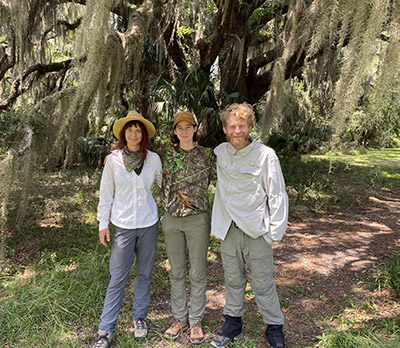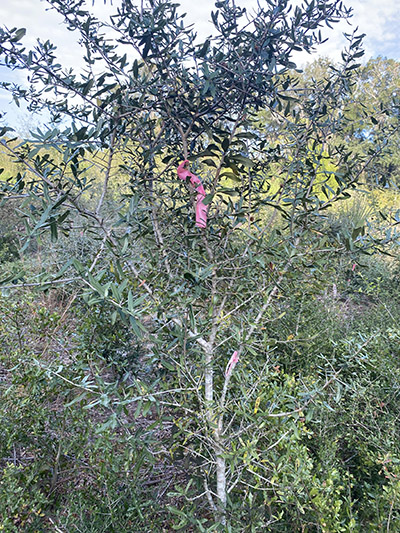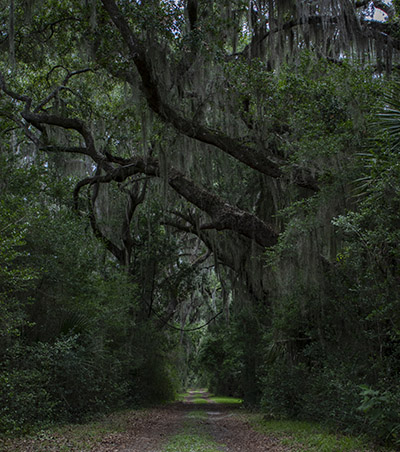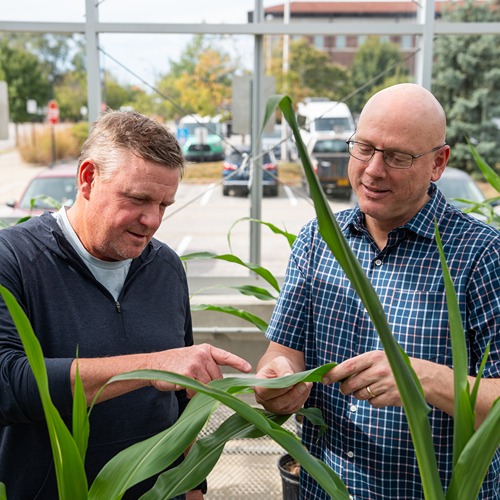Research Aims to Assist with Southern Live Oak Restoration
How do planting density, fertilizer and mulch affect the growth of southern live oak (Quercus virginiana Mill.) restoration plots in maritime forests?
restoration plots in maritime forests?
A recently published open access paper in the special issue of Forests titled Production in Forest Nurseries, Field Performance of Seedlings and Natural Regeneration in the Context of Climate Change addresses these variables in relationship to a planting on Cannon’s Point Preserve on St. Simons Island in Georgia.
The article “Response of Live Oak Regeneration to Planting Density, Fertilizer and Mulch,” which details a study aimed to set foundational knowledge of how to grow southern live oak in a restoration setting, was co-authored by 2024 master’s degree alumna Brianne Innusa, Dr. Doug Jacobs and Dr. Owen T. Burney (PhD 2011), research director and associate professor in the John T. Harrington Forest Research Center at New Mexico State University.
Southern live oak is a keystone species in maritime forests along the southeastern Atlantic Coast nd it serves as the dominant canopy species that many plant and animal species depend on for habitat. In recent years, the regeneration of these oaks has been hindered by loblolly pine (Pinus tadea L.), a native but weedy tree species that exists in coastal Maritime forests in high proportions due to prior land use as loblolly pine plantations and the close proximity of these plantations. Additionally, southern live oak is a slower growing species and is susceptible to damage from deer browse and overtopping from competing vegetation.
In order to see how live oak seedlings were affected by planting density as well as the use of fertilizer, researchers planted 720 one-year-old southern live oak seedlings at a planting density of 1 meter, 2 meters and 3 meters with initial applications of mulch, fertilizer, mulch plus fertilizer or no application.
Findings from the experiment did not fall in line with the initial hypothesis that planting density would have a major effect on seedling growth over the study period. Instead, fertilizer and mulch had more impact.
“We found that fertilizer had initial positive effect on groundline diameter, which could be a potential indicator of increased belowground root growth,” said Innusa, who currently serves as a research assistant in Jacob’s Forest Regeneration and Restoration Lab. “Planting density did not have a significant effect on seedling growth over the first four years, but more time may be needed to see that effect as seedlings begin to compete for aboveground and belowground space and resources such as water, nutrients, sunlight, etc.
“Our most surprising result was the positive effect one application of mulch made on groundline diameter, height and crown width, well into the fourth growing season. A light mulch application with wood chips is something a landowner could easily implement on their own land and it can increase the initial growth of southern live oaks.”
The St. Simons Land Trust, which owns, protects and maintains Cannon’s Point Preserve, is thankful for this research, which gives them foundational knowledge of how to plant southern live oak seedlings in their restoration plots and builds upon the previous four phases of research that have been completed on the property.
"Maritime forest restoration research taking place at Cannon’s Point Preserve has played a large role in the preserve’s goal of being a platform for education and model for conservation,” said Stephanie Knox, stewardship director for the land trust. “One of the preserve’s top management goals is to restore acres of planted pine back to the maritime forest that would have historically been here prior to significant human impacts. Thanks to the dedication and enthusiasm of our partners at Purdue University and New Mexico State University, we are attaining this goal while simultaneously having broad impacts educating the local coastal conservation community on maritime forest resiliency, the immediate threats, and understanding the most comprehensive and feasible ways to restore this significant ecosystem. The St. Simons Land Trust is excited and grateful to be a part of this groundbreaking research."
stewardship director for the land trust. “One of the preserve’s top management goals is to restore acres of planted pine back to the maritime forest that would have historically been here prior to significant human impacts. Thanks to the dedication and enthusiasm of our partners at Purdue University and New Mexico State University, we are attaining this goal while simultaneously having broad impacts educating the local coastal conservation community on maritime forest resiliency, the immediate threats, and understanding the most comprehensive and feasible ways to restore this significant ecosystem. The St. Simons Land Trust is excited and grateful to be a part of this groundbreaking research."
This research, which represents one experiment from Innusa’s master’s thesis work, built upon previous experiments in coastal Georgia which looked at deer exclusion, shade tolerance and fencing alternatives and their impact on southern live oak regeneration.
Funding support for this project was provided by the USDA National Institute of Food and Agriculture, the Hardwood Tree Improvement and Regeneration Center, the Fred M. van Eck Forest Foundation, the John T. Harrington Forest Research Center at New Mexico State University and the St. Simons Land Trust. In kind support was provided by St. Simons Land Trust, The Nature Conservancy and the Georgia Department of Natural Resources.
Although the research team may circle back to Cannon’s Point Preserve at a later date to remeasure seedling height, diameter and crown width, they have turned their focus to setting up a new project at Harris Neck National Wildlife Refuge next year, which will continue to look at the effects of competition on live oak seedlings.





